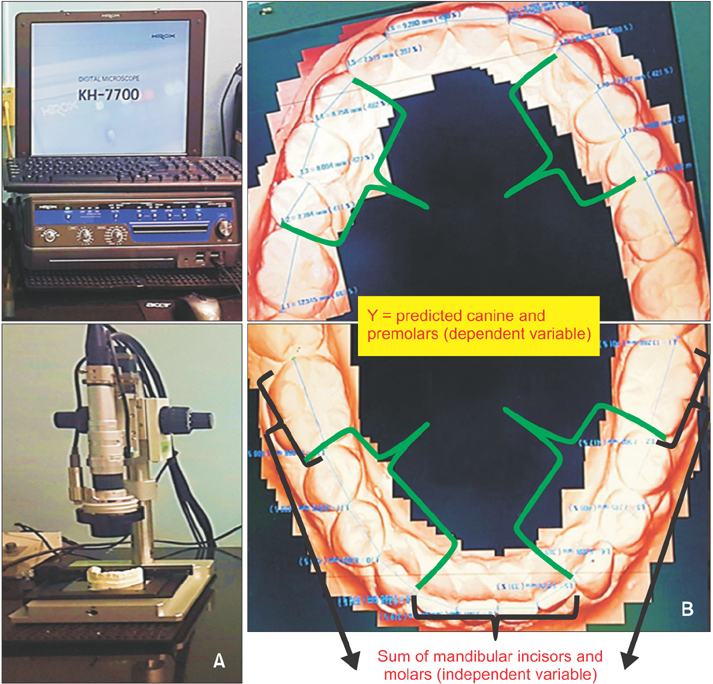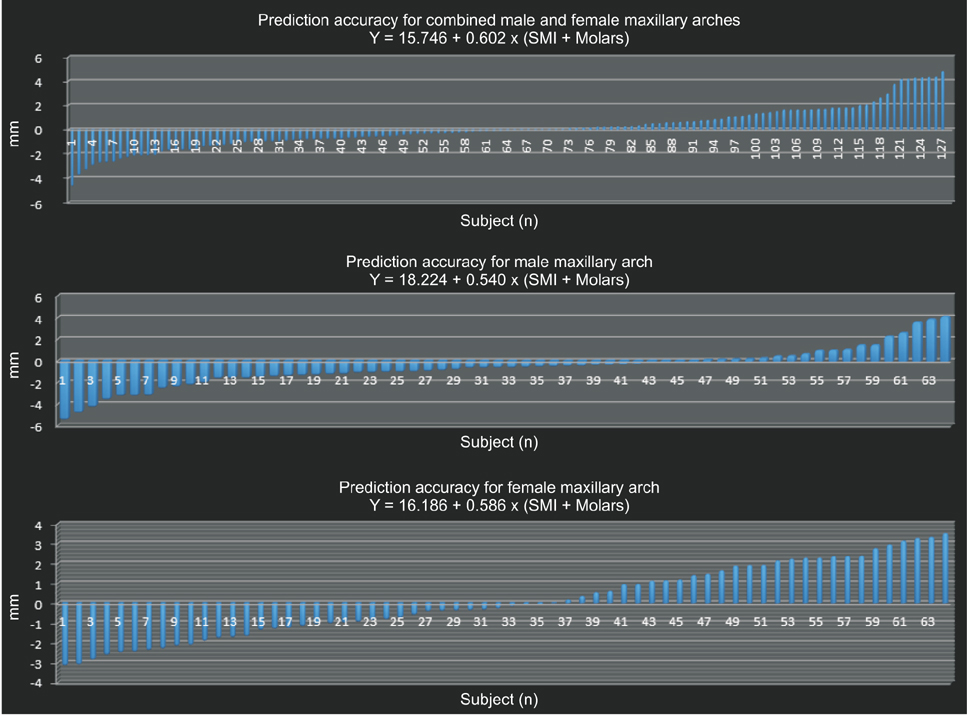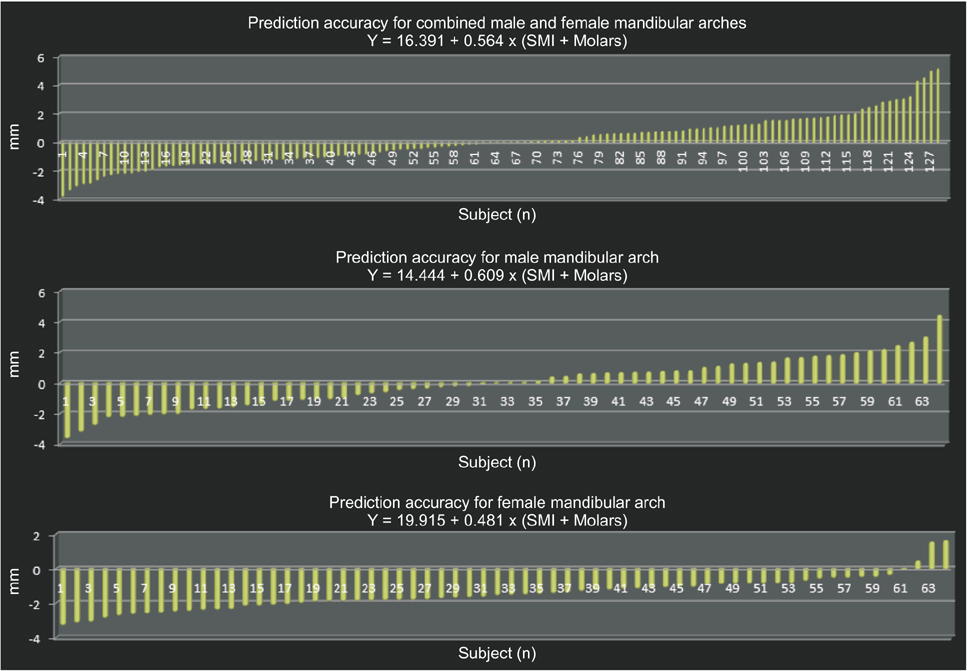Korean J Orthod.
2016 May;46(3):171-179. 10.4041/kjod.2016.46.3.171.
New prediction equations for the estimation of maxillary mandibular canine and premolar widths from mandibular incisors and mandibular first permanent molar widths: A digital model study
- Affiliations
-
- 1Orthodontic Unit, School of Dental Science, Universiti Sains Malaysia, Kota Bharu, Malaysia. dralam@gmail.com
- 2Forensic Dentistry Unit, School of Dental Science, Universiti Sains Malaysia, Kota Bharu, Malaysia.
- KMID: 2164261
- DOI: http://doi.org/10.4041/kjod.2016.46.3.171
Abstract
OBJECTIVE
The primary aim of the study was to generate new prediction equations for the estimation of maxillary and mandibular canine and premolar widths based on mandibular incisors and first permanent molar widths.
METHODS
A total of 2,340 calculations (768 based on the sum of mandibular incisor and first permanent molar widths, and 1,572 based on the maxillary and mandibular canine and premolar widths) were performed, and a digital stereomicroscope was used to derive the the digital models and measurements. Mesiodistal widths of maxillary and mandibular teeth were measured via scanned digital models.
RESULTS
There was a strong positive correlation between the estimation of maxillary (r = 0.85994, r2 = 0.7395) and mandibular (r = 0.8708, r2 = 0.7582) canine and premolar widths. The intraclass correlation coefficients were statistically significant, and the coefficients were in the strong correlation range, with an average of 0.9. Linear regression analysis was used to establish prediction equations. Prediction equations were developed to estimate maxillary arches based on Y = 15.746 + 0.602 × sum of mandibular incisors and mandibular first permanent molar widths (sum of mandibular incisors [SMI] + molars), Y = 18.224 + 0.540 × (SMI + molars), and Y = 16.186 + 0.586 × (SMI + molars) for both genders, and to estimate mandibular arches the parameters used were Y = 16.391 + 0.564 × (SMI + molars), Y = 14.444 + 0.609 × (SMI + molars), and Y = 19.915 + 0.481 × (SMI + molars).
CONCLUSIONS
These formulas will be helpful for orthodontic diagnosis and clinical treatment planning during the mixed dentition stage.
Figure
Cited by 1 articles
-
Reference points suitable for evaluation of the additional arch length required for leveling the curve of Spee
Yong-Hwa Cho, Sung-Hoon Lim, Sung-Nam Gang
Korean J Orthod. 2016;46(6):356-363. doi: 10.4041/kjod.2016.46.6.356.
Reference
-
1. Alam MK, Iida J. Overjet, overbite and dental midline shift as predictors of tooth size discrepancy in a Bangladeshi population and a graphical overview of global tooth size ratios. Acta Odontol Scand. 2013; 71:1520–1531.
Article2. Bishara SE, Jakobsen JR, Abdallah EM, Fernandez Garcia A. Comparisons of mesiodistal and buccolingual crown dimensions of the permanent teeth in three populations from Egypt, Mexico, and the United States. Am J Orthod Dentofacial Orthop. 1989; 96:416–422.
Article3. de Paula S, Almeida MA, Lee PC. Prediction of mesiodistal diameter of unerupted lower canines and premolars using 45 degrees cephalometric radiography. Am J Orthod Dentofacial Orthop. 1995; 107:309–314.
Article4. Lima Martinelli F, Martinelli de Lima E, Rocha R, Souza Tirre-Araujo M. Prediction of lower permanent canine and premolars width by correlation methods. Angle Orthod. 2005; 75:805–808.5. Ballard ML, Wylie WL. Mixed dentition case analysis, estimating size of unerupted permanent teeth. Am J Orthod. 1947; 33:754–759.
Article6. Tanaka MM, Johnston LE. The prediction of the size of unerupted canines and premolars in a contemporary orthodontic population. J Am Dent Assoc. 1974; 88:798–801.
Article7. Moyers RE, Riolo M. Early treatment. Handbook of orthodontics. 4th ed. Chicago, IL: Year Book Medical Publishers Inc.;1988. p. 422–426.8. Al-Bitar ZB, Al-Omari IK, Sonbol HN, Al-Ahmad HT, Hamdan AM. Mixed dentition analysis in a Jordanian population. Angle Orthod. 2008; 78:670–675.
Article9. Staley RN, Kerber PE. A revision of the Hixon and Oldfather mixed-dentition prediction method. Am J Orthod. 1980; 78:296–302.
Article10. Bishara SE, Staley RN. Mixed-dentition mandibular arch length analysis: a step-by-step approach using the revised Hixon-Oldfather prediction method. Am J Orthod. 1984; 86:130–135.
Article11. Vandenbroucke JP, von Elm E, Altman DG, Gøtzsche PC, Mulrow CD, Pocock SJ, et al. STROBE initiative. Strengthening the Reporting of Observational Studies in Epidemiology (STROBE): explanation and elaboration. Ann Intern Med. 2007; 147:W163–W194.12. Williams AC, Stephens CD. A modification to the incisor classification of malocclusion. Br J Orthod. 1992; 19:127–130.
Article13. Prabhu S, Acharya AB. Odontometric sex assessment in Indians. Forensic Sci Int. 2009; 192:129.e1–129.e5.
Article14. Dupont WD, Plummer WD Jr. Power and sample size calculations for studies involving linear regression. Control Clin Trials. 1998; 19:589–601.
Article15. Shahid F, Khursheed Alam M, Fadhli Khamis M, Muraoka R, Nakano K, Okafuji N. Validity and reliability of digital model measurements: a digital stereomicroscopic study. J Hard Tissue Biol. 2014; 23:439–444.
Article16. Alam MK, Shahid F, Purmal K, Ahmad B, Khamis MF. Bolton tooth size ratio and its relation with arch widths, arch length and arch perimeter: a cone beam computed tomography (CBCT) study. Acta Odontol Scand. 2014; 72:1047–1053.
Article17. Shahid F, Khursheed Alam M, Fadhli Khamis M, Honda Y, Sugita Y, Maeda H. Geomorphometrics of tooth size and arch dimension analysis by conventional digital caliper and digital stereomicroscope to establish standard norms for the pakistani population. J Hard Tissue Biol. 2015; 24:155–168.
Article18. Houston WJ. The analysis of errors in orthodontic measurements. Am J Orthod. 1983; 83:382–390.
Article19. Malgady RG, Krebs DB. Understanding correlation coefficients and regression. Phys Ther. 1986; 66:110. 112. 114.
Article20. Adnani IQ, Shahid F, Zaman S, Ahmed F, Saleem M. Application of Moyer's prediction table in a sample of Karachi population. Pak Orthod J. 2011; 3:16–20.21. Zilberman O, Huggare JA, Parikakis KA. Evaluation of the validity of tooth size and arch width measurements using conventional and three-dimensional virtual orthodontic models. Angle Orthod. 2003; 73:301–306.22. Bell A, Ayoub AF, Siebert P. Assessment of the accuracy of a three-dimensional imaging system for archiving dental study models. J Orthod. 2003; 30:219–223.
Article23. Leifert MF, Leifert MM, Efstratiadis SS, Cangialosi TJ. Comparison of space analysis evaluations with digital models and plaster dental casts. Am J Orthod Dentofacial Orthop. 2009; 136:16.e1–16.e4. discussion 16
Article24. Stevens DR, Flores-Mir C, Nebbe B, Raboud DW, Heo G, Major PW. Validity, reliability, and reproducibility of plaster vs digital study models: comparison of peer assessment rating and Bolton analysis and their constituent measurements. Am J Orthod Dentofacial Orthop. 2006; 129:794–803.
Article25. Melgaço CA, de Sousa Araújo MT, de Oliveira Ruellas AC. Mandibular permanent first molar and incisor width as predictor of mandibular canine and premolar width. Am J Orthod Dentofacial Orthop. 2007; 132:340–345.
Article26. al-Khadra BH. Prediction of the size of unerupted canines and premolars in a Saudi Arab population. Am J Orthod Dentofacial Orthop. 1993; 104:369–372.
Article27. Legović M, Novosel A, Legović A. Regression equations for determining mesiodistal crown diameters of canines and premolars. Angle Orthod. 2003; 73:314–318.28. Bherwani AK, Fida M. Development of a prediction equation for the mixed dentition in a Pakistani sample. Am J Orthod Dentofacial Orthop. 2011; 140:626–632.
Article29. Kieser JA, Groeneveld HT. Fluctuating odontometric asymmetry in an urban South African black population. J Dent Res. 1988; 67:1200–1205.
Article30. Kieser JA, Groeneveld HT, Preston CB. Fluctuating odontometric asymmetry in the Lengua Indians of Paraguay. Ann Hum Biol. 1986; 13:489–498.
Article31. Alam MK, Shahid F, Purmal K, Ahmad B, Khamis MF. Tooth size and dental arch dimension measurement through cone beam computed tomography: effect of age and gender. Res J Recent Sci. 2014; 3:85–94.32. Khamis MF, Taylor JA, Malik SN, Townsend GC. Odontometric sex variation in Malaysians with application to sex prediction. Forensic Sci Int. 2014; 234:183.e1–183.e7.
Article33. Garn SM, Lewis AB, Kerewsky RS. Sexual dimorphism in the buccolingual tooth diameter. J Dent Res. 1966; 45:1819.
Article34. Lakhanpal M, Gupta N, Rao NC, Vashisth S. Tooth dimension variations as a gender determinant in permanent maxillary teeth. JSM Dent. 2013; 1:1014.35. Townsend G, Brown T. Tooth size characteristics of Australian Aborigines. Occas Pap Hum Biol. 1979; 1:17–38.36. Alam MK, Hassan R, Mahmood Z, Haq ME. Determination and comparison of tooth size and tooth size ration in normal occlusion and different malocclusion groups. Int Med J. 2013; 20:462–465.37. Bernabé E, Major PW, Flores-Mir C. Tooth-width ratio discrepancies in a sample of Peruvian adolescents. Am J Orthod Dentofacial Orthop. 2004; 125:361–365.
Article
- Full Text Links
- Actions
-
Cited
- CITED
-
- Close
- Share
- Similar articles
-
- Prediction of the sum of mesiodistal widths of the unerupted permanent canines and premolars
- A study on the prediction percentile tabulation of the size of the unerupted permanent canines and premolars in Korean population
- The effect of mandibular position on measurement in spiral tomography
- Correlations between mesiodistal crown diameters of permanent teeth
- A study on estimating tooth size with regression constants





